The Best Surf Guide: Tenerife
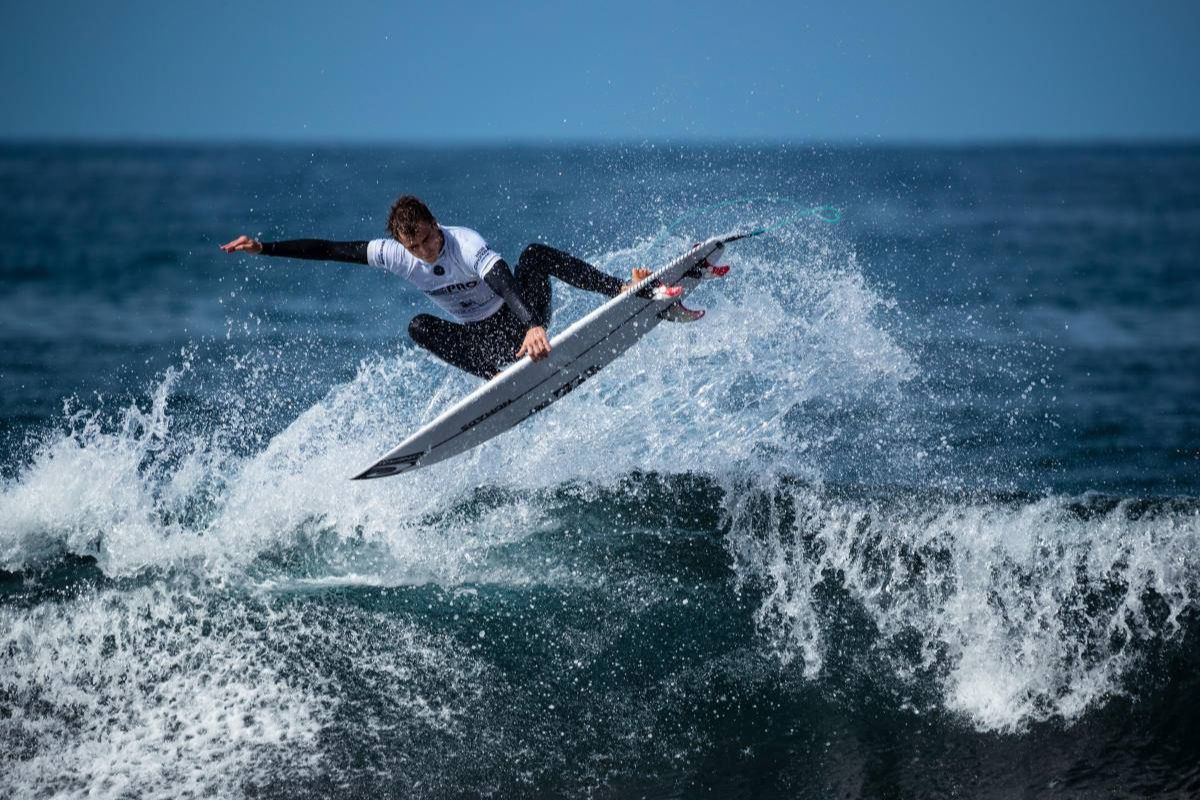
Tenerife is the largest island of the Canary archipelago.
Not only noted for its volcanic landscapes and climates, but also has positioned itself as one of the most attractive surfing destinations in Europe. It contains a wide variety of spots that suit both beginners and experienced surfers. The contrast between the north and south of the island is also reflected in its beaches, where respect for the sea, the coexistence between athletes and nature make the difference.
Tenerife stands out for its ability to combine adventure, relaxation, tradition and modernity. The island is home to the imposing Teide (the highest peak in Spain), charming coastal villages, a gastronomy rich in local products and a tourist offer that satisfies both the active traveler and the wellness lover.
Discover why Gran Tenerife is one of Europe’s best kept treasures in this article.
Index of Our Tenerife Surf Guide
What is the best time to surf in Tenerife?
One of the most attractive decisions to surf in Tenerife and not in another island, is the possibility of enjoying good waves practically all year round. Thanks to its subtropical climate and its location in the middle of the Atlantic. The mild temperatures ranging between 19 and 25 ° C and the constancy of the waves make the island in a top surfing destination, both in winter and summer.both in winter and summer.
In addition, the water temperature in Tenerife does not usually drop below 19 °C, which makes it possible to surf comfortably with light wetsuits or even without having to use neoprene in the warmer months. This climatic stability, coupled with the diversity of waves, makes the island an ideal place for both winter getaways and summer vacations focused on surfing.
The best season for surfing in Tenerife is between October and March, when the ocean is most active and the Atlantic tides reach the island’s coasts with more force. During these months, northern spots such as Punta del Hidalgo or Benijo offer bigger, more powerful waves, ideal for intermediate and advanced surfers looking for demanding challenges.
On the other hand, the summer season, from April to September, is characterized by milder conditions, with smaller waves but also more constant in the south of the island, especially on beaches like El Médano or Las Américas. This period is perfect for those who are just starting out in surfing or wish to perfect their technique in calmer waters, without giving up a spectacular setting.
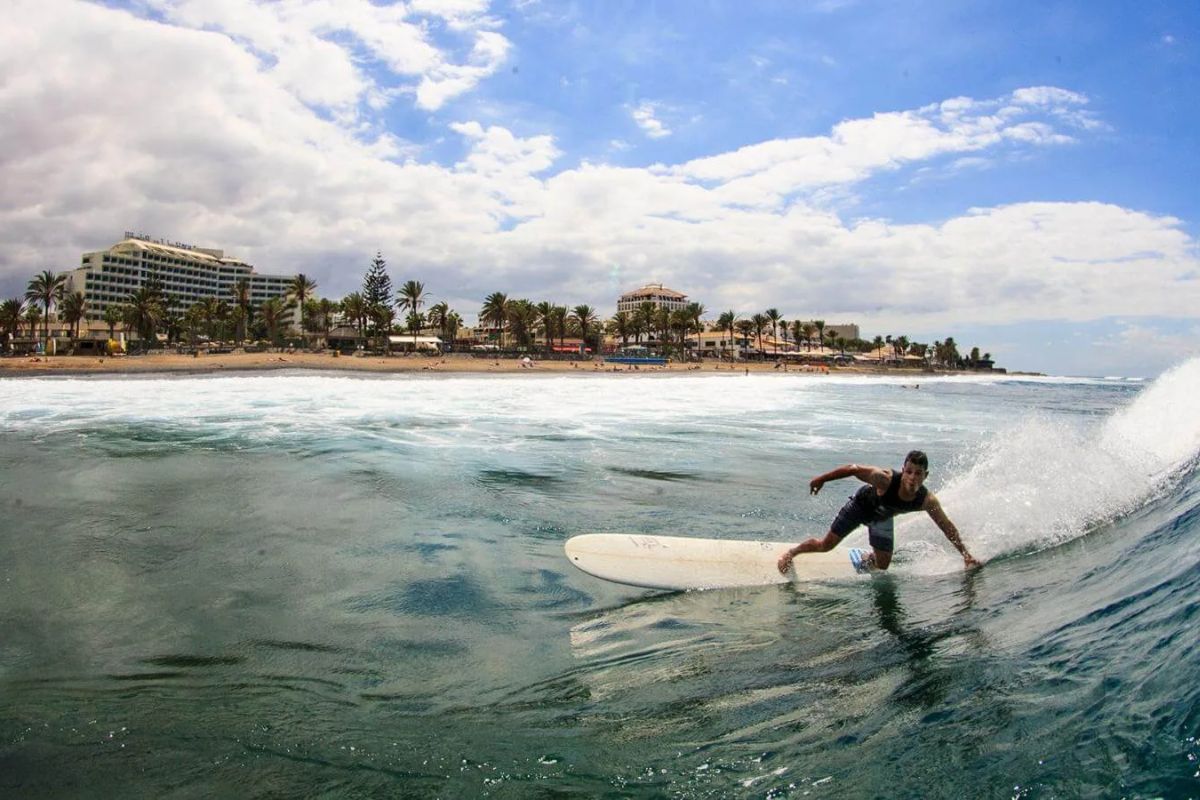
Surfing for all levels: perfecting, ideal spots and tips
Tenerife stands out as an accessible and versatile island for all types of surfers. Both beginners and experienced surfers find here a perfect environment to progress, enjoy and face new challenges.
Beginners: Tenerife offers sandy bottom beaches and gentle waves, ideal for learning without risk and safety. Areas such as Las Americas, have surf schools specialized in several languages, certified instructors and equipment rental services, which facilitates a safe and stimulating first contact. Courses usually include theory on safety, sea dynamics, basic technique and guided practice, with equipment adapted to each level. These beaches, with moderate-sized waves and warm waters, are perfect for familiarizing yourself with the board and gaining confidence.
Intermediate level: For surfers who already master some basic maneuvers will find multiple options to evolve their technique, face faster waves and gain fluency. Beaches such as El Médano or Bajamar offer variable conditions depending on the tide and wind, which allows you to work on skills such as wave reading, timing or maneuvers in more technical sections. Many schools also offer improvement or personalized classes, with video recordings, technical analysis and specific sessions to develop more advanced maneuvers. In addition, surf camps and specialized accommodations facilitate a better stay and coexistence with other surfers.
Advanced and professional: The north of the island presents real challenges. Spots like Punta del Hidalgo or El Callao are known for their powerful breakers, volcanic rock bottoms and waves that can reach imposing heights in high season. During the autumn and winter months, the Atlantic tides arrive with considerable intensity. These areas require experience, board control and a deep respect for sea conditions. It is essential to know the currents, the precise reading of the series of…
This combination of diverse environments and conditions makes Tenerife a perfect destination to evolve as a surfer, no matter where you start. From the first wave to the most challenging, the island offers different paths that accompany surfers at every stage of their journey.
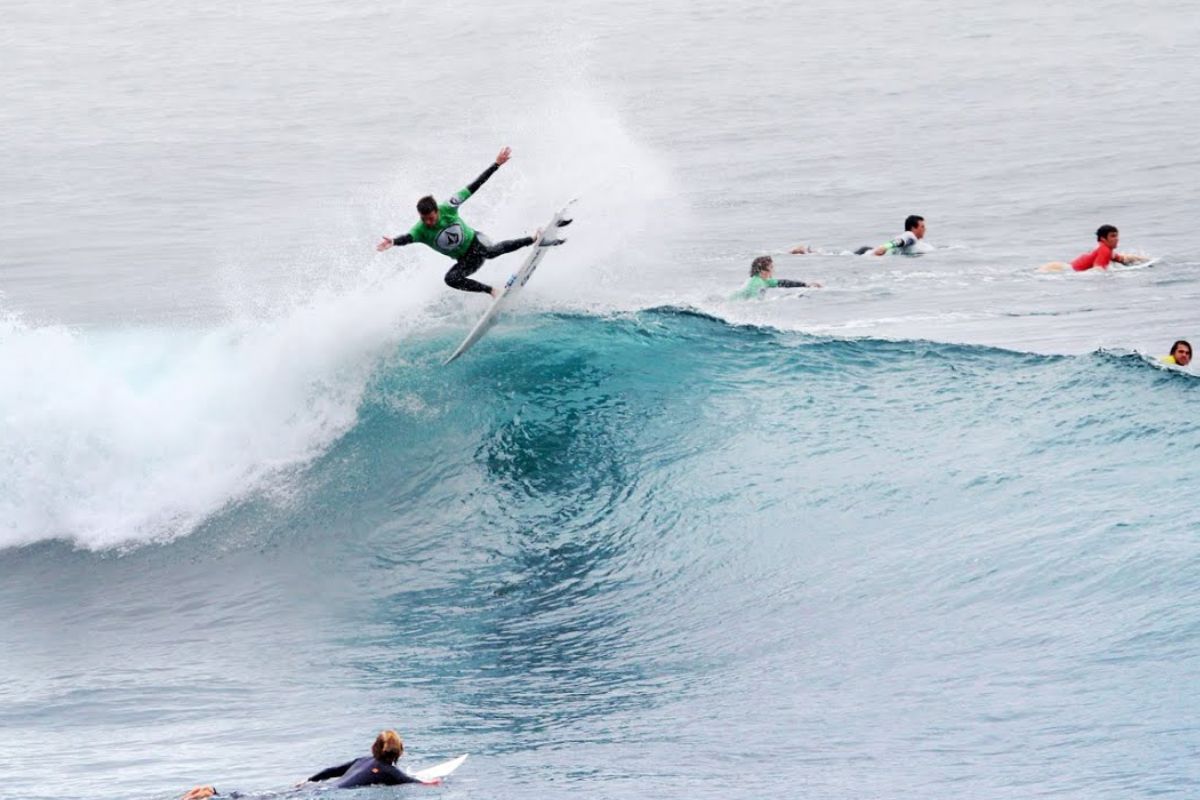
Surfing events in Tenerife
For decades, Tenerife’s beaches have been a meeting point for generations of local, visiting and international surfers who have made surfing a true lifestyle. This lively culture is reflected both in the relaxed atmosphere of the coastal towns and in the calendar of events and competitions that animate the island every year. Some of the most outstanding events are:
Las Américas Pro
It is an official test of the world circuit of the World Surf League held every winter in Playa de Las Americas in which highlights the famous wave of La Izquierda. It is a wave with volcanic bottom and fast and hollow sections, ideal for progressive maneuvers and tubes.
This event brings together professional surfers from around the world and turns the area into a surfing epicenter where surfers compete to score points in the world ranking. There are different activities such as: exhibitions, live music, sports fairs, photo exhibitions, yoga classes and activities for all ages. In addition to its technical level, the championship stands out for its organization and the support it receives from both professional institutions and the local public.
Open Surf La Marea
It is usually held on the beach of El Socorro. This championship is part of the Canary Islands surfing circuit and brings together local and regional athletes in junior, open and master categories. It should be noted that it has a sandy and rocky bottom and its waves are known for their consistency and power.
Tenerife hosts numerous regional and local competitions, such as the Canarian surfing and bodyboarding championships.
Punta Blanca Young Series
It focuses on future young people who will end up being promising surfers, and other bodyboard and longboard competitions. These events, although they do not have the international projection of Las Americas Pro, are fundamental for the growth of surfing in Tenerife and the different surrounding islands, as they promote local talent and consolidate a solid base of emerging athletes.
But the surf culture in Tenerife goes far beyond the competitions.
A diverse and open community has grown up around surfing, which is reflected in the surf camps and surf campsand informal encounters with different surfers. Spaces where advice is shared, good sessions are held and friendships are forged in and out of the water. The island has a commitment to the natural environment and to coexistence in the sea, which is one of the most deeply rooted values in the local surfing community.
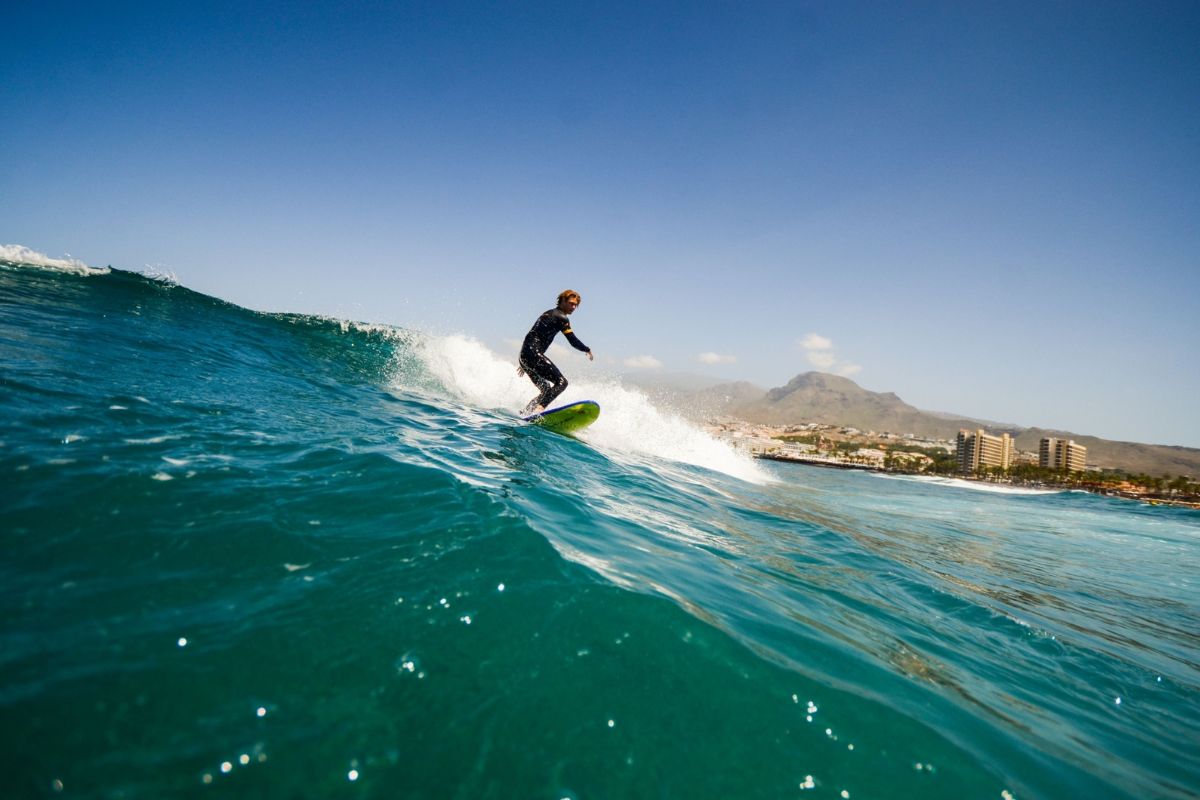
Top 5 surfing beaches in Tenerife to enjoy the waves almost all year round
El Médano Beach
It is one of the most popular destinations for lovers of surfing, windsurfing and kitesurfing. Its waves are constant and of medium size, ideal for those looking to improve their technique in a natural environment. Located in the south of the island, this beach of golden sand and constant wind is also an international meeting point for the surfing community.
Punta del Hidalgo Beach
Located in the north, this beach offers powerful and breaking waves on a volcanic background that attract expert surfers in search of technical challenges. This beach is noted for its waves that can exceed 3 meters in high season. Its environment is ideal for those seeking to surf demanding waves in an imposing natural setting thanks to the strength of the Atlantic.
Playa de Las Americas
This enclave in the south of Tenerife is known for its softer and more accessible waves, a perfect place that facilitates the practice of this sport for beginners and intermediates. In addition to having multiple surf schools and equipment rentals, with restaurants, stores and accommodations that facilitate the stay for those who want to combine surfing and leisure. Its breakers allow safe surfing, with waves that break in both beachbreak and pointbreak.
Benijo Beach
Renowned for its stunning scenery and consistent waves, it is a spot located in the north of the island that offers conditions for intermediate and advanced surfers . Its rocky bottoms and the influence of the Atlantic swell generate cylindrical and powerful waves, ideal for those seeking technical challenges in a quieter environment away from mass tourism.
Punta del Hidalgo
Just a few minutes from Bajamar, it is a natural refuge surrounded by cliffs, coastal paths and strong waves. Its waves, of moderate size, are suitable for medium level surfers, who can enjoy a safe and varied experience. In addition, the area has surf school services since there are advanced surf spots with powerful, breaking and fast waves, apart from being a frequent place for bodyboarding.
Socorro Beach
One of the most popular beaches in the north among local surfers. El Socorro has a strong character combining black volcanic sand, a stunning natural environment and powerful waves that attract riders all year round. It is also awarded with blue flag. It offers surf lessons with local instructors available for all levels. After a long surf session the restaurant “El Socorro” is ideal, very close to the beach and traditional food.
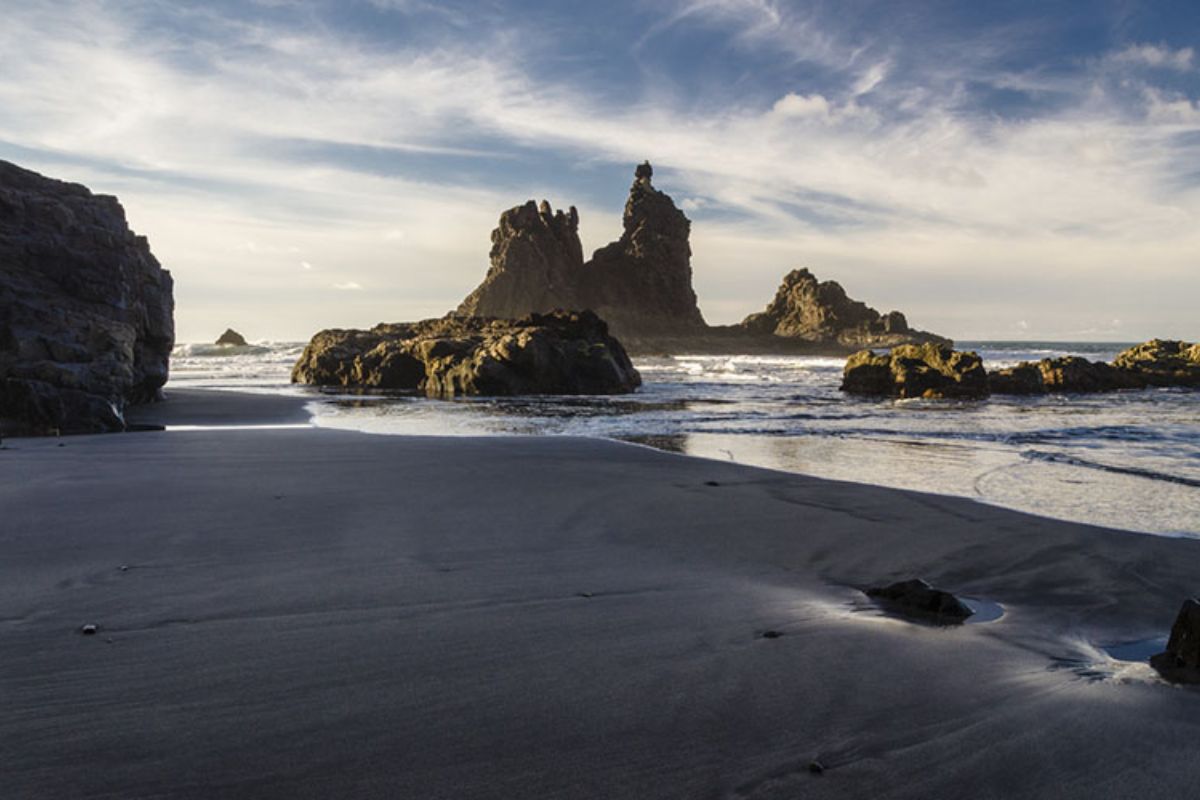
Immerse yourself in the aquatic activities of Tenerife
Surf
Tenerife is an internationally recognized destination for its surfing where you can enjoy numerous beaches with different waves, ideal for beginners and experts. You can find different surf schools and surfboard rentals, facilitating the practice and learning. They are present in almost all coastal areas. In addition, the local surfing environment is wonderful, with competitions and events that globalize surfing throughout the year.
Diving and snorkeling
The crystal clear waters of Tenerife hide a surprising marine wealth. You will find certified dive centers, where you can explore underwater caves, volcanic reefs and a varied fauna including tropical fish, octopus and rays. Local dive centers organize guided dives for all levels, providing equipment and training.
For those who prefer something gentler, snorkeling is an ideal option to explore near-shore reefs and enjoy the biodiversity without the need to dive for a long period of time underwater.
Night snorkeling
A magical experience that allows you to discover the active marine life after sunset. In protected and organized points, such as on the coast of Costa Adeje, night dives are performed with snorkeling equipment and special lights to observe fish and bioluminescent organisms. This activity requires an expert guide to ensure safety and preserve the environment.
Paddle surf
Paddle surfing has become a very popular activity in the calm waters of Tenerife. You can enjoy long, leisurely rides in the sea exploring the coast from another perspective or even practice yoga on the board. A very repetitive activity for locals and tourists is to watch the sunset from a paddle surf board.
Kayak
Kayaking is an active and adventurous way to explore the coast, especially the impressive rock formations, cliffs, sea caves, observe marine fauna such as dolphins or turtles…. There are guided routes guaranteeing safety and access to special points inaccessible by land that allow all these activities. It is an activity suitable for all ages, ideal to enjoy with family or friends.
Sailing and catamaran
Sailing the waters of Tenerife is an experience that combines relaxation and adventure. They usually offer multiple options for sailing, from private sailboat rentals which is an option for those seeking exclusivity and privacy to catamaran excursions. It is common to see dolphins and whales during the trips, and some boats have services for swimming and snorkeling in the open sea. They also offer catering services or music to complete an unforgettable day.
Sport fishing
For fishing lovers, Tenerife is an outstanding destination, with waters rich in species such as tuna, swordfish and billfish. It is a traditional activity in Tenerife that attracts enthusiasts from all over Europe. Excursions can be booked combining sport and adventure on the high seas. Related competitions and events are also organized, promoting active and sustainable tourism.
Windsurfing and kitesurfing
Both windsurfers and kitesurfers find here a paradise to practice and improve their technique. The constant wind in certain areas makes Tenerife a privileged place for this sport. There are schools and equipment rental for those who want to start or improve their technique in these disciplines. In addition, international competitions are usually held in summer, attracting sportsmen and tourists, making the area more dynamic and creating a cosmopolitan atmosphere.
Bodyboard
Bodyboarding is very popular on beaches with powerful waves, being an accessible and fun modality, especially for those who enjoy speed and direct contact with the force of the sea. In addition, it is often a gateway for the youngest to the world of waves, for its ease and immediate fun.
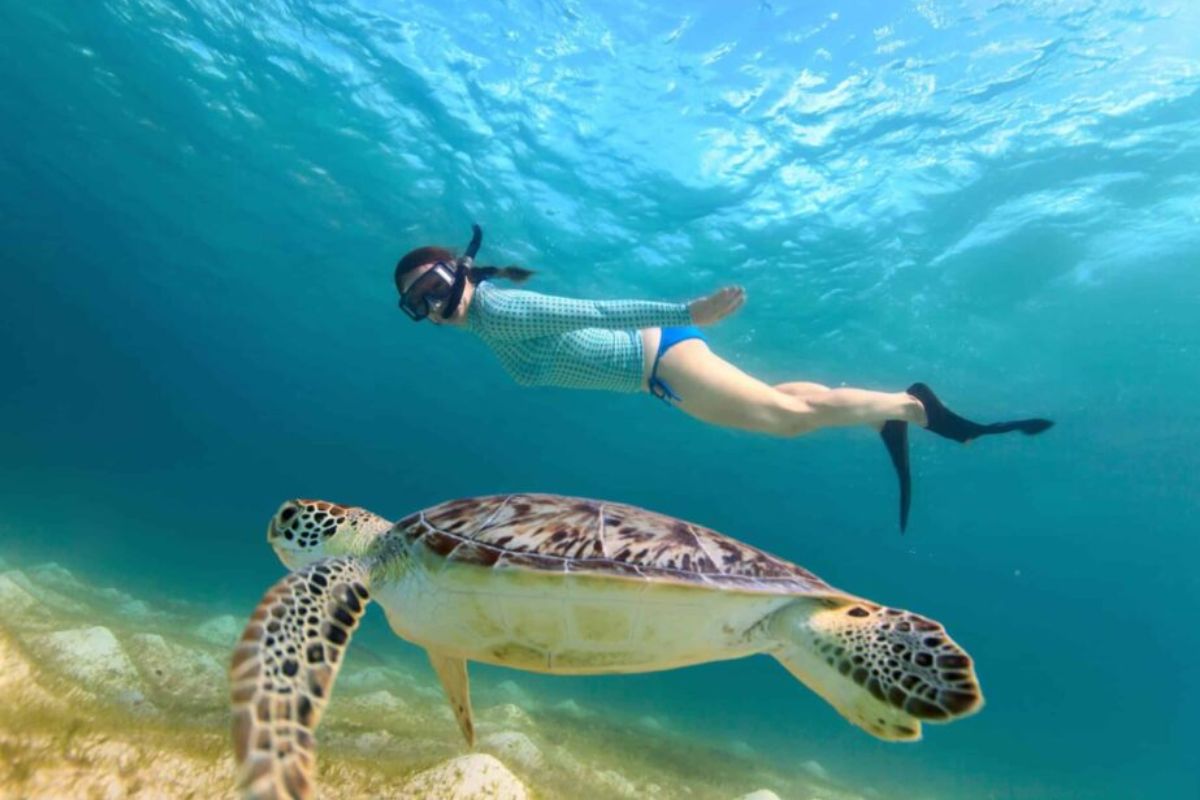
Discover the wonder of the island: “El Teide”.
Teide is the highest peak in Spain with 3,715 meters high, this volcanic peak is the beating heart of Tenerife. It is mandatory to visit it calmly to discover all its corners and contemplate the wonderful place it is.
Declared a World Heritage Site by Unesco, the Teide National Park is home to one of the most impressive volcanic landscapes on the planet. Apart from dominating the horizon of the island, it is the greatest natural history of the Canary archipelago. Some curiosities:
- It is the third highest volcano in the world from its oceanic base, behind only Mauna Kea and Mauna Loa (Hawaii).
- Its environment has been the setting for films and documentaries, from “Rage of the Titans” to NASA productions to simulate Mars.
- For centuries, the Guanches considered it a sacred place, home of the demon Guayota, to whom they attributed its eruptions.
- It is home to endemic flora and fauna such as the Teide violet. It is a flower that only grows at more than 2,500 meters. You can also observe different species of insects and reptiles that are not found anywhere else in the world.
- It changes color depending on the time of day, for example: At sunrise or sunset, Teide adopts pink, orange or even lilac tones. In winter you can see how the peak of Teide can be covered with snow.
Apart from being able to climb the crater of the volcano and take guided tours, it is essential that you do not leave without visiting these places:
Roques de García:
They are unique rock formations, which seem to be sculpted by giants.
Viewpoint of La Ruleta:
One of the most iconic panoramic views, overlooking the Teide and the rocks.
Teide cable car:
In a few minutes you get up to 3,555 meters. From there, if you have permission you can walk to the peak itself.
El Llano de Ucanca:
A huge volcanic plain that looks like a different planet.
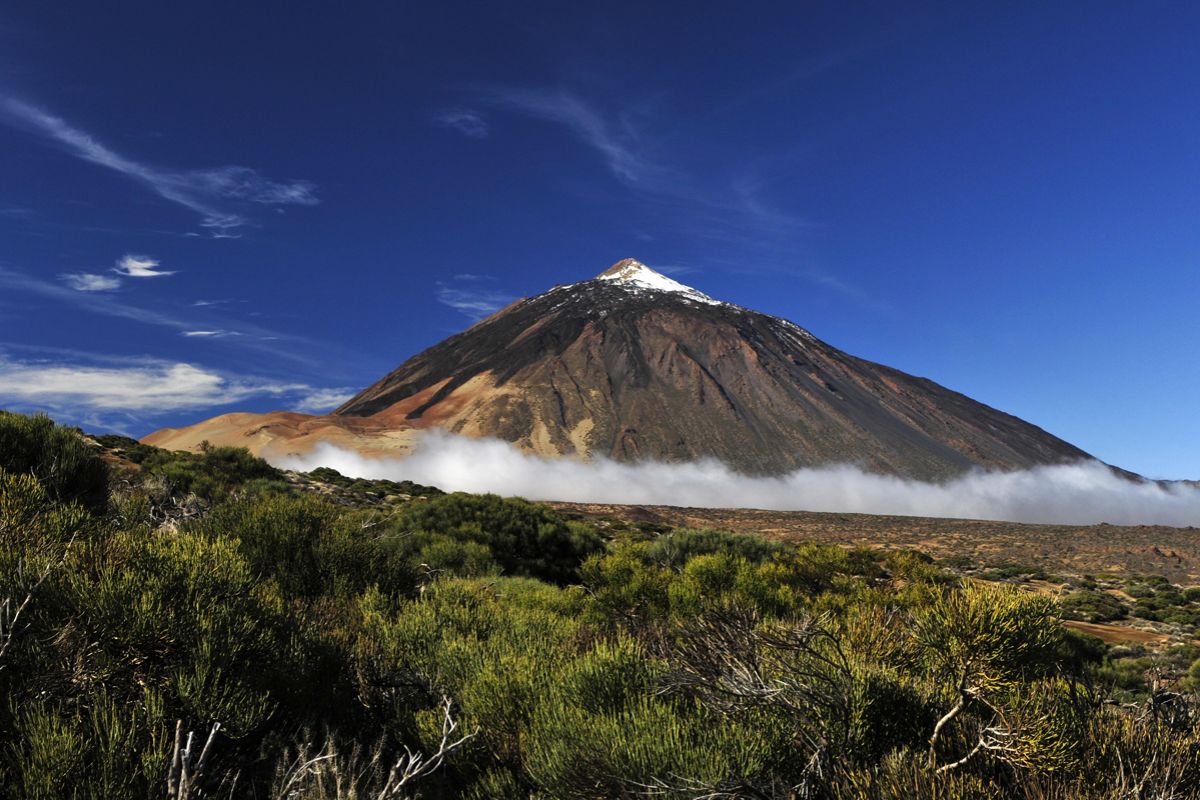
Routes and trails on Teide
Teide is full of marked trails, adapted to all levels, and many of them offer one of the best ways to get to know its true essence. Some recommended routes:
Trail 3
Roques de García: It is a circular route with 3.5 km of route, very popular and of low difficulty. Ideal to start since its duration is approximately 1.5 hours. It is one of the most accessible and popular routes as it is ideal for families or for those who want a short walk but with spectacular views. It allows to contemplate the famous Roques de García, geological formations such as the iconic Roque Cinchado, symbol of the park.
Trail 7
It requires a good physical condition, but it is the most direct route to the crater of the volcano; it requires an official permit which is free and must be requested a few weeks in advance. This route lasts approximately 6 hours. This is the classic route for those who want to hike Teide on foot. It starts in the area of Montaña Blanca, where you cross pumice fields and ancient rivers of solidified lava, and ends in front of the largest volcanic crater of the island.
Route 4
Siete Cañadas: It is an ancient Guanche road of communication between the canyons. This trail crosses the park from east to west and allows you to see many little-traveled corners of Teide. It has a duration of approximately 6 hours. It can be done in sections and connect with other trails depending on how many km you want to travel. The longest route is 16.6 km which requires a good physical condition.
It is recommended to bring warm clothes even in summer sincetemperatures can change radically as you go up the mountain. It is necessary to carry water and something to eat since not all the routes have food stands. Solar radiation is more intense at these altitudes, so it is advisable to use a high sun protection.
Teide at night is a place where you will find stars that you will not see anywhere else.
When the sun goes down, Teide National Park is transformed. Its altitude and low light pollution make it one of the best places in the world to see the stars. It is no coincidence that one of the most important astrophysical observatories on the planet is located here. You can hire guided night tours or simply go on your own to a viewpoint such as Las Minas de San José or the Mirador de los Azulejos. Some of the guides include telescopes and talks about astronomy, which is highly recommended for a unique experience on a summer day.
Here, far from light pollution, at high altitude and with a clean atmosphere, you can see constellations, planets, satellites, meteor showers and on the clearest nights, even the Milky Way. This was recognized by the Starlight Foundation, which certified it as a Starlight Tourist Destination for the quality of its skies.
Several companies offer guided tours at dusk, where you walk along gentle trails while a guide explains the volcanic flora. At nightfall, the starry sky is detailed with the help of telescopes. One of the best places for this is around the Mirador de Tabonal Negro.
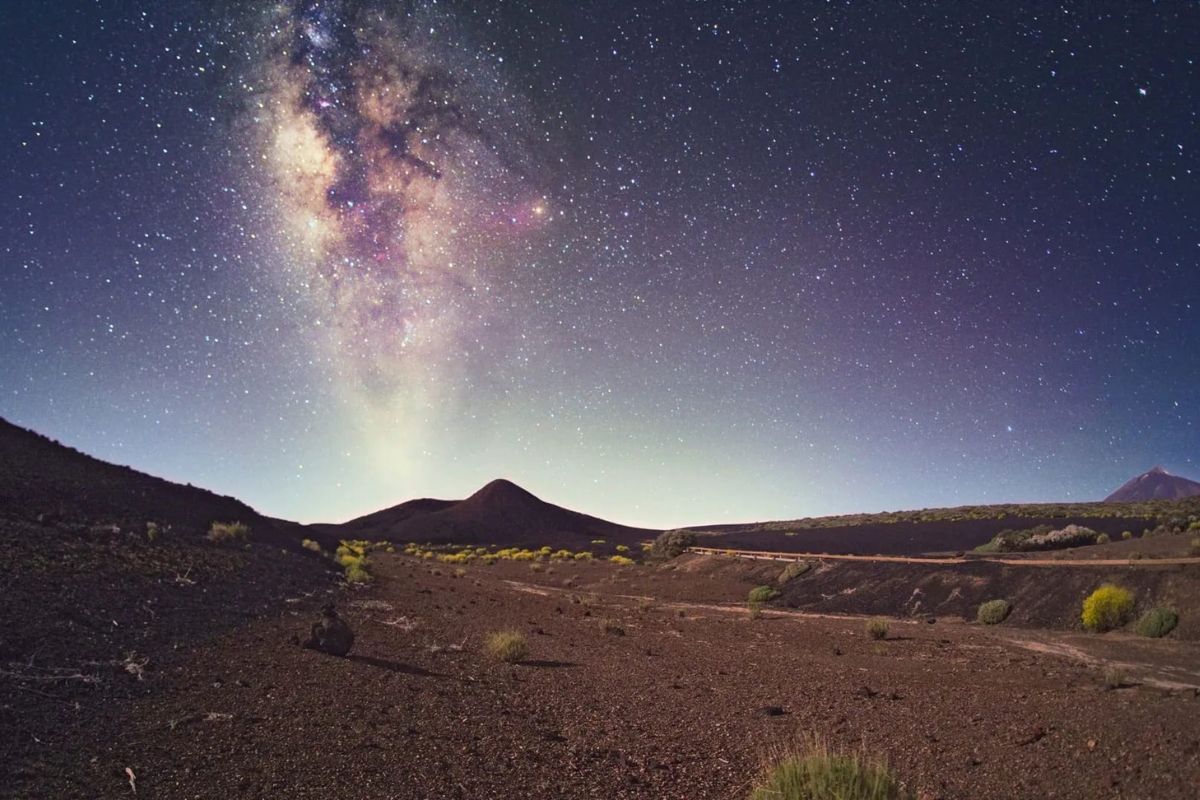
Tenerife beyond Teide
Tenerife is much more than sun and beach, it is an island that mixes volcanic nature, viewpoints and trails that will make you forget your cell phone. Whether you travel for the first time or if you repeat, there are places that are surprising considering that Tenerife is an island to discover little by little. And if you like surfing, moving between these places allows you to know different coastal areas and perhaps discover your next favorite spot.
El Barranco del Infierno
Located in Adeje, the Barranco del Infierno is one of the most spectacular, best preserved hiking trails on the island and almost 50% of its territory is integrated by protected natural areas. It offers a pure natural paradise as a well-marked trail that takes approximately 6.5 hours to hike. It is located between high rock walls, vegetation and the constant sound of water.
It is the only route in Tenerife that ends at a natural waterfall (a luxury on this volcanic island). For this reason, access is regulated: only 300 people can enter per day, so it is advisable to book in advance. The spectacular Caidero, a large waterfall of more than 200 meters formed by the waters of the rising Roque Abinque.
The Millenary Dragon Tree and the Wind Cave
It is approximately 800 years old. The Drago Milenario is located in Icod de los Vinos and is one of the most emblematic natural symbols of Tenerife. This endemic species, with its twisted trunk and reddish sap, measures 18 meters high, it seems to be taken out of a legend. To visit this tree is not only to see a botanical rarity, but to be introduced into the history and mythology of the island. You can see it in the Plaza de la Constitución or go inside to see it better in the park of the Drago Milenario. If you surf in the area of El Socorro or San Marcos, it is a highly recommended stop to rest and reconnect with the natural history of Tenerife.
Also in Icod de los Vinos is another hidden treasure: the Cueva del Viento, one of the longest volcanic corners of the world, with more than 17 kilometers explored. It is one of the most impressive volcanic caves in Tenerife, entering it is like entering the volcanic heart of the island. The tour is usually done with a guide and helmet “not recommended for children under 5 years or people with mobility problems”. Inside you can observe different geomorphological phenomena and fossils; where you can discover a system of tunnels, levels and formations created by ancient lava flows. The visit is combined with a short walk through a beautiful rural setting, and is perfect if you are looking for a cooler plan on days when the wind or waves do not accompany.
Los Gigantes, a spectacular sight
On the west coast of Tenerife, the cliffs of Los Gigantes rise up to 600 meters above the sea, forming a landscape that looks like something out of a documentary. These vertical walls fall into the ocean in such an imposing way that they were revered by the Guanches, who considered them a sacred place.
You can see them from the marina and take a boat trip to see them from the sea and closer with luck, accompanied by dolphins and whales. You can also kayak or snorkel in its crystal clear waters.
Anaga Rural Park
The Anaga massif is a true natural treasure of the island, declared a Biosphere Reserve by Unesco in 2015. The massif has an average height of about 850 meters above sea level and extends through the municipalities of Santa Cruz de Tenerife, San Cristóbal de La Laguna and Tegueste. It is home to some of the oldest laurel forests in Europe, with trails, unique vegetation, thousands of animal species, ravines and viewpoints that offer incredible views between the mountains and the sea.
Here, each route seems like a portal to another world: from the Path of the Senses, perfect for the whole family, to more demanding trails such as the one that goes down to Benijo beach, one of the wildest and most spectacular on the island. To learn more about the uniqueness of the Anaga Rural Park, a visit to the Cruz del Carmen Visitor Center is a must.
Pyramids of Güímar
It is an ethnographic park where six stepped stone pyramids have given rise to various theories and studies. Although for some they are agricultural structures built by the ancient local inhabitants, other researchers such as Thor Heyerdahl, the famous Norwegian explorer defended, defends their possible ceremonial origin and their relationship with other civilizations. It is a space full of symbolism, themed gardens, exhibitions on oceanic cultures… Ideal for those who love mysteries, and perfect for alternating culture and a perfect excursion from Santa Cruz de Tenerife, since it is only 28 kilometers away.
Loro Parque
Located in Puerto de la Cruz, it is one of the most recognized and visited zoos in the world for its focus on conservation and animal welfare. With over 400 species of parrots, an impressive aquarium, penguinarium and animal exhibits such as orcas, sea lions and dolphins, it is a must visit if you are traveling with children, friends, family or couples. It has a well-known bird show called the Loro Show.
The penguinarium, Planet Penguin, the largest in the world, stands out. In this place the amazement is a constant increasing empathy and love for the animal world. The area known as Katandra Treetops is also a highlight, the setting for one of the most incredible free-flight aviaries in the world. In this corner of the park you can feel the South American rainforest, the jungle or the harmony of the Zen garden.
There are many attractions and attractions in this park that stands out for its initiatives in defense of the environment and conservation of species.
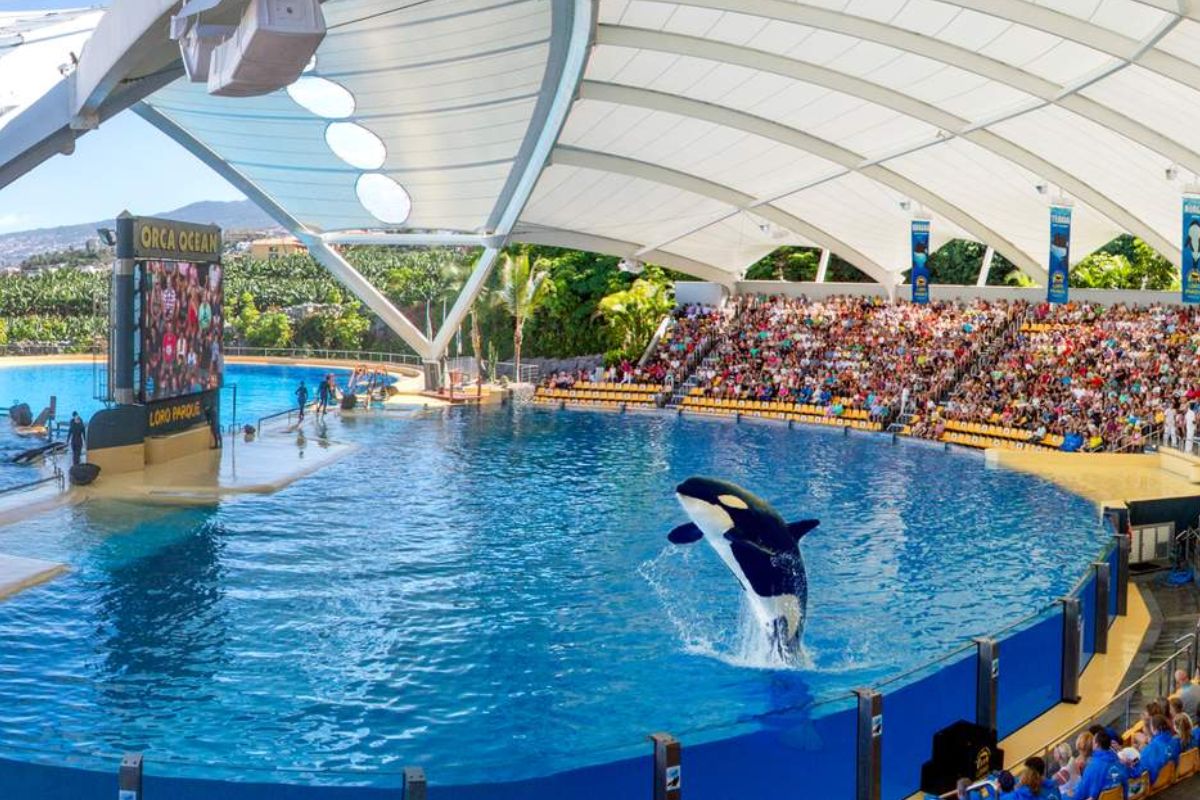
The beaches of Tenerife are treasures of sand and salt.
Tenerife is an island that can also be discovered through its coastline. Each beach has its own atmosphere, enclaves that preserve their natural character… From volcanic sands to natural pools, these beaches hide unique landscapes and a coastal life that invites you to both the surfing as well as relaxation and disconnection.
Las Teresitas Beach
Located in the charming fishing village of San Andrés. The most curious thing is that its sand is not native, but was brought from the Sahara desert in the 70’s to transform this local beach into a more touristic enclave. It is undoubtedly one of the most recognized beaches of the island. With calm, transparent waters and views of the Anaga Mountains, it is perfect for a day of disconnection and swimming in peace and quiet. A highly recommended activity is to attend yoga classes on the sand, very common in the mornings. If after a day at the beach you feel like something to eat, the restaurant “Cofradía de Pescadores de San Andrés” is located overlooking the sea and has the best fresh fish in the area.
Garden Beach
This beach combines volcanic nature with exotic gardens, trails, waterfalls and landscaped areas that make it unique. The contrast between the black sand, the blue of the sea and the green of the palm trees makes Playa Jardín one of the wildest beaches on the island. Nearby is the Loro Park. You can enjoy a variety of restaurants overlooking Puerto de la Cruz, traditional meals, local dinners, adjusted prices … It is common to see local surfers entering the water when conditions are good, especially in the area furthest from the main promenade.
La Tejita Beach
It is a virgin beach, located at the foot of the Montaña Roja, this extensive beach of golden sand is one of the quietest in the south of Tenerife. Not being as urbanized as others, it is perfect for those seeking spaciousness, breeze and disconnection. It is a good choice for beginners in bodyboarding, paddle surfing or just to enjoy a swim with a view. It is common that people who make trails through the Montaña Roja end up on this beach refreshing.
El Porís de Abona
Located in the southeast of the island, El Porís is a small coastal town that maintains the charm of a traditional fishing village. Its beach of dark sand and clean waters is not usually crowded. Nearby is the small pier, where free diving among fish is common and the Punta de Abona lighthouse, to the south, is a good place to end the day with a view and taking pictures that you will always remember. For decades, it was one of the strategic points for fishermen in the southeast. Today, you can still see small boats stranded on the sand, recalling that seafaring past.
Bajamar
More than a beach, Bajamar is a coastal resort with a perfect blend of tradition, sport and relaxation. Its main attraction are the natural pools that fill up with the sea swell, ideal for swimming safely even when the swell is intense. On days with high waves, the water that enters the pools can reach several meters in height, making swimming a unique and fun experience. You can stroll along a small black sand beach and watch the classic sunsets of the island.
Almáciga Beach
Located in one of the most spectacular environments of Tenerife, this wild black sand beach is a small paradise for surfers looking for consistent waves in an incomparable natural setting. The access requires some mountain road, but the reward is total. It is one of the few beaches where the roads still cross banana plantations before reaching the sea. That mixture of agriculture and coast gives it an authentic and rural air. You can enjoy a magical sunset, without light pollution or overcrowding.
Los Dos Hermanos Beach / El Callao
This small virgin beach is very close to Almáciga and Benijo, but with an even more isolated character. Its name refers to the two large twin rocks that protrude from the water and that, seen from afar, look like sisters. They are accessed by paths from the road, which makes them authentic hidden corners of the island. It has a unique rock formation for photography, picnics or hiking. There are no restaurants on the beach itself, but going up to the village of Taganana you can find different options such as “Casa Picar”.
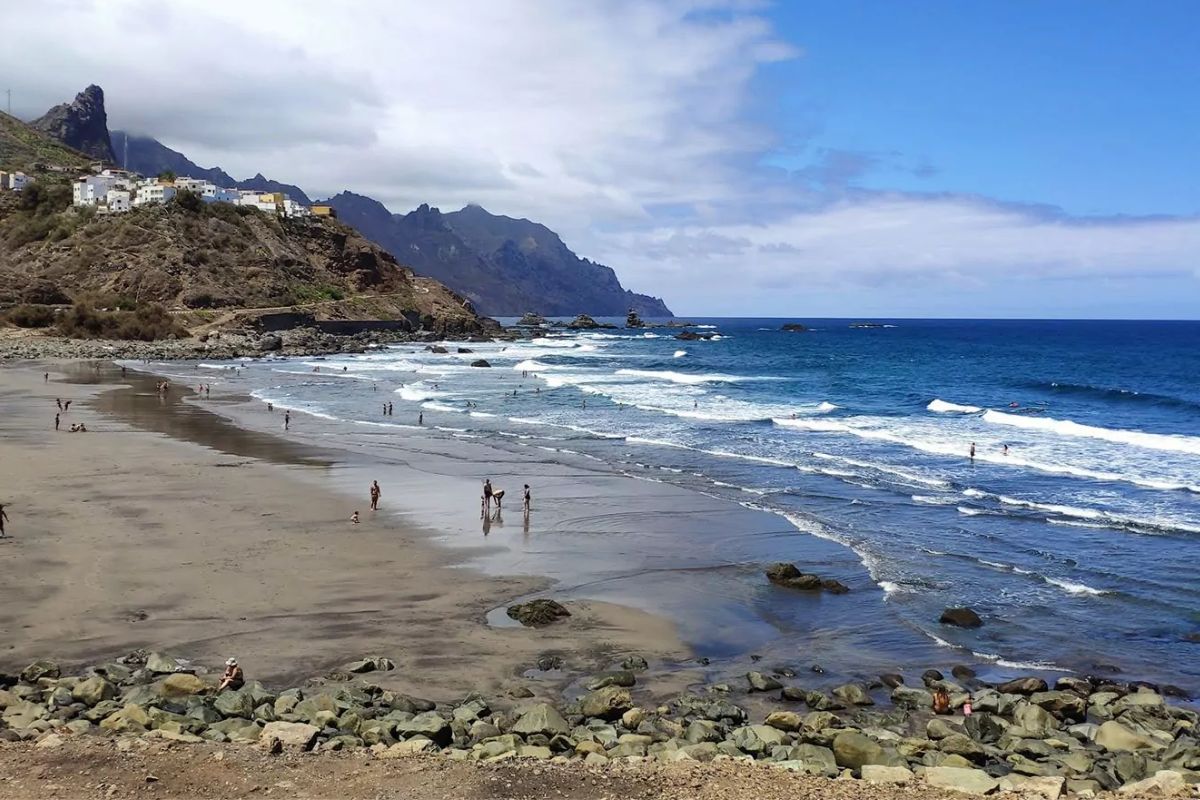
Must-do outdoor activities to enjoy Tenerife
Hiking
Tenerife is a paradise for nature lovers, with more than 1,500 km of marked trails. The variety of trails allows both beginners and experts to enjoy exploring the island on foot. From the lush laurel forests of Anaga to volcanic routes on Mount Teide, there are options for all levels. Some of the most outstanding routes are the Barranco del Infierno, where you walk through deep canyons to a natural waterfall, or the Roques de García, rock formations that look like sculptures.
Cycling
The island is one of the favorite destinations for professional cyclists and adrenaline lovers. Demanding routes such as the ascent to Teide with almost 40 km of ascent and significant slopes or softer routes in the north, among vineyards and forests. For mountain biking lovers, there are routes through pine forests and woods in La Esperanza or the Rural Park of Anaga, with technical roads and breathtaking landscapes that combine nature and nature.
Paragliding
One of the most impressive experiences. You can paraglide from points such as Ifonche, Taucho, Izaña or Los Realejos. It is an unforgettable experience! Paragliding is a unique experience to contemplate Tenerife from the sky. The sensation of floating over ravines, forests and the Atlantic Ocean is as exciting as it is relaxing, ideal for those looking for a safe and accessible adventure.
Skydiving
An extreme experience for the most daring. Although it is not as common as paragliding, there are companies that offer it from airfields in the south of the island, with jumps over 3,000 meters high. This experience allows you to experience free fall while observing the volcano and the sea. Each person who does it challenges his or her personal limits and experiences an intense dose of adrenaline, everyone repeats.
Landscape photography
The contrasts of Tenerife; volcanoes, cliffs, forests and ocean. They turn the island into a perfect scenery for photography. From the sunrise in the Anaga Rural Park, where the fog envelops the forest, to the volcanic contrasts of Teide or the cliffs of Los Gigantes at sunset, each corner offers a unique palette of colors. The island is a natural space to experiment with light, texture and contrast.
Climbing and canyoning
Areas such as Arico are famous among climbers of all levels for their challenging volcanic rock walls. For the more adventurous, there are ideal canyons to descend with a guide to ensure safety and enjoy the scenery. It also offers an intense contact with nature, descending canyons and waterfalls in places like El Carrizal or Los Arcos.
Quad or buggy tours
It is a fun way to tour the island full of land, pine forests and volcanic areas. Routes are organized from the south of the island to higher areas. This allows us to access less traveled corners while enjoying speed and adventure in the middle of an incomparable natural environment.
Yoga or outdoor meditation
Increasingly popular in quiet, natural locations. Many yoga sessions combine hiking with relaxation practices, these activities combine physical and mental well-being with a deep connection to the island.
Horseback riding
Horseback riding can be done in rural areas of the south or north, through agricultural landscapes, ancient trails or pine forests. Offering another way to discover its landscapes in a unique way. Depending on the site, it may be possible to ride between different places, enjoying nature together with the animals and with the company of expert guides.
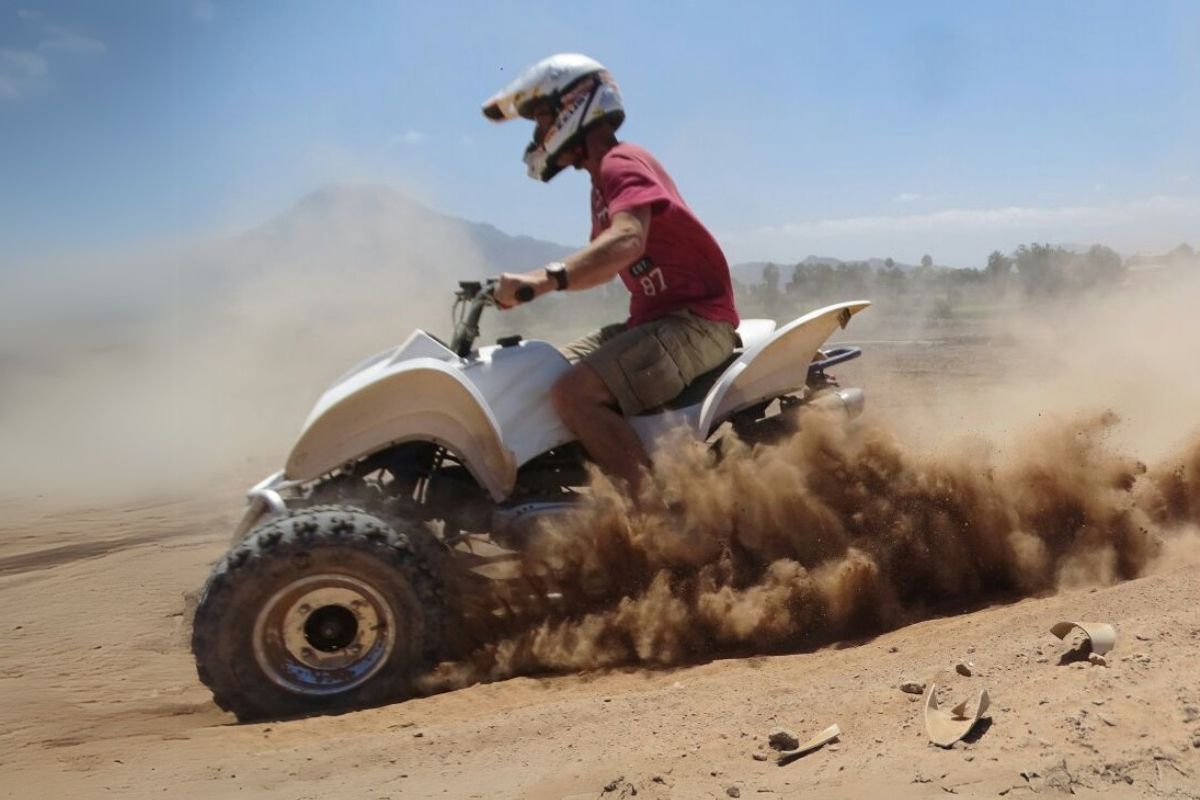
What to do for free in Tenerife?
Natural viewpoints
Viewpoints such as La Paz, El Bailadero or Los Roques offer breathtaking panoramic views of the island, the ocean and the volcanic landscape. They are accessible free of charge and perfect for photographers or lovers of views, especially at sunrise or sunset.
Craft markets and local fairs
Many towns and cities in Tenerife hold traditional markets and open-air fairs where you can stroll around, learn about local products and enjoy the festive atmosphere without spending money. The experience of walking through the stalls and talking to the artisans is a unique experience. This makes up the reflection of the culture in the different places of the island.
The natural pools of Garachico
Garachico, with its history linked to volcanic lava, offers natural pools where the sea enters forming saltwater pools. The beauty of the landscape, with cliffs and unique rock formations, invites you to relax and contemplate the calm Atlantic.
Free temporary exhibitions in cultural centers
The cultural centers and museums organize temporary exhibitions with free admission where you can contemplate from contemporary art to samples of local history, these spaces are an excellent opportunity to enjoy art and culture.
Volunteer activities
For those who wish to get more involved with the island, there are volunteer programs that invite you to collaborate in environmental conservation, beach clean-ups or support community events. These free experiences offer the opportunity to contribute to the care of the environment while meeting people and experiencing Tenerife from a unique perspective.
Free cultural events and festivals
Concerts in squares, street theater, folk festivals or gastronomic fairs… Participating in these events allows you to get to know the local culture in an authentic and close way, enjoying the music, dance and local traditions of the island.
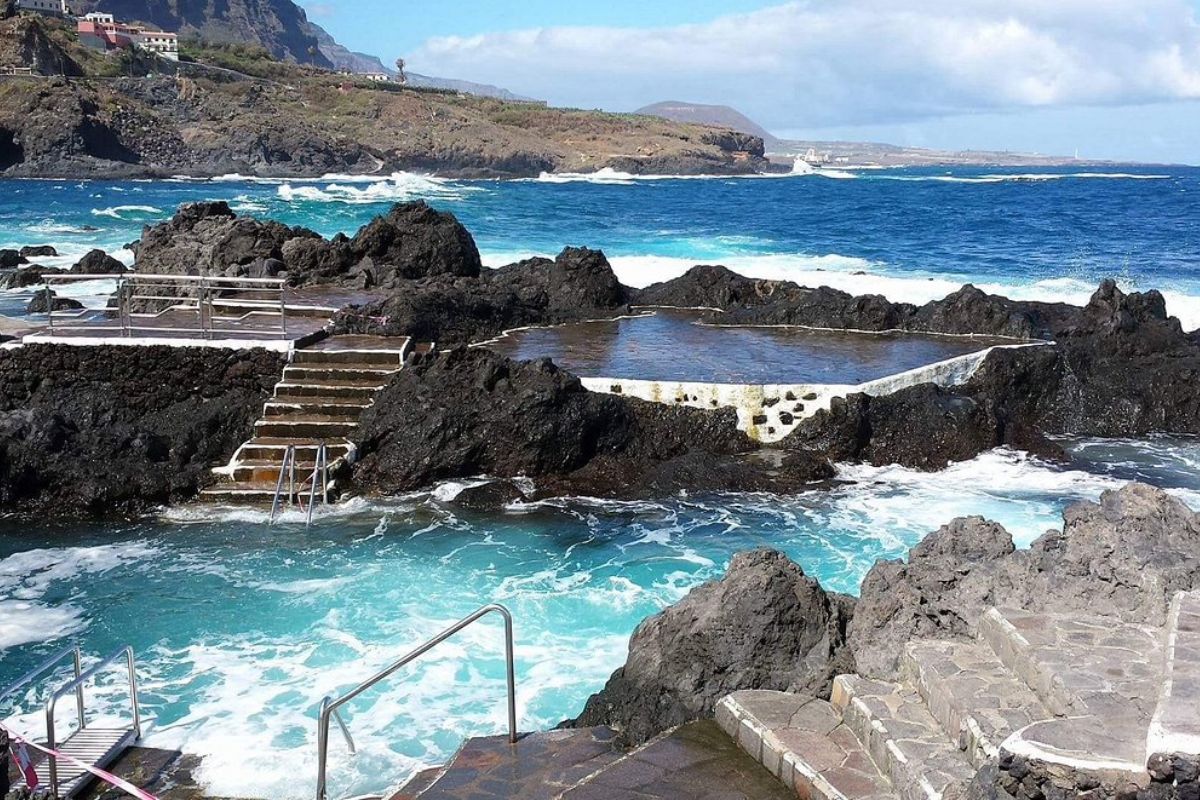
Santa Cruz de Tenerife, much more than a capital city
Santa Cruz de Tenerife, apart from being the capital of the island, is also the cultural and social heart of the north of Tenerife. It is a dynamic city that combines history and traditions, art and modernity with the unmistakable Canarian character. It offers the visitor an experience that blends historic architecture, contemporary art, local markets and a vibrant street life.
What to see in Santa Cruz de Tenerife?
Tenerife Auditorium “Adán Martín
This spectacular building is one of the most modern symbols of the Canary Islands, designed by architect Santiago Calatrava. Its silhouette is reminiscent of a wave or an unfurled sail, which symbolically connects it with the ocean. It not only stands out for its design, but also for its programming as it hosts classical music concerts, opera, dance and contemporary shows. It is one of the best places to live a different cultural experience.
Castle of San Juan Bautista
Located next to the auditorium, this castle was built in the 17th century as part of the city’s defensive system. Its nickname “Black Castle” comes from the dark tone of the volcanic stones with which it was built. It was key in the defense of Santa Cruz during Horatio Nelson’s invasion attempt in 1797. It is very well preserved and is one of the few examples of ancient military architecture in the city.
Tenerife Espacio de las Artes
A modern and avant-garde cultural center that houses contemporary art exhibitions, an excellent library and a cinematheque with independent film screenings. The building is the work of architects Herzog & de Meuron. In addition, its cafeteria is a popular spot for students and local artists.
Garcia Sanabria Park
It is located in the urban center and is an ideal place to disconnect amidst the green of its leaves. Its paths mix fountains, modern sculptures, tropical flowers and centennial trees. It is common to see locals strolling, reading or practicing yoga outdoors. Its huge floral clock, covered with live flowers, has been one of the most photographed corners for decades.
Plaza de España
It is the largest square in the Canary Islands and acts as the heart of the city. There is a huge artificial lake, rest areas and the Monument to the Fallen, a column that has been part of the urban landscape since the Franco era.
Market of Our Lady of Africa
This neo-colonial style market is one of the liveliest places in Santa Cruz. Its patios and aisles are filled with aromas of tropical fruit, fresh fish, flowers and Canarian spices. In addition to buying local products such as bananas, papayas, mojos or artisan cheeses, it is the ideal place to try a quick tapa or have breakfast like a local.
Church of La Concepción
Considered as the spiritual cradle of the city, this church dates back to the 16th century and was built shortly after the conquest of Tenerife. Its bell tower and baroque details attract attention, as well as its interior altarpiece. In addition to its religious value, it is an ideal place to understand the historical evolution of the city. In its surroundings there are cobblestone streets, small squares and traditional houses that make up one of the most authentic neighborhoods.
Neighborhood of El Toscal
It is one of the most soulful neighborhoods of Santa Cruz. Its low houses, with colorful facades and wooden balconies, preserve the air of an old town. Here you will not find great monuments, but you will find the essence of the traditional city: craft workshops, small stores, traditional bars and murals with urban art that contrast with its history.
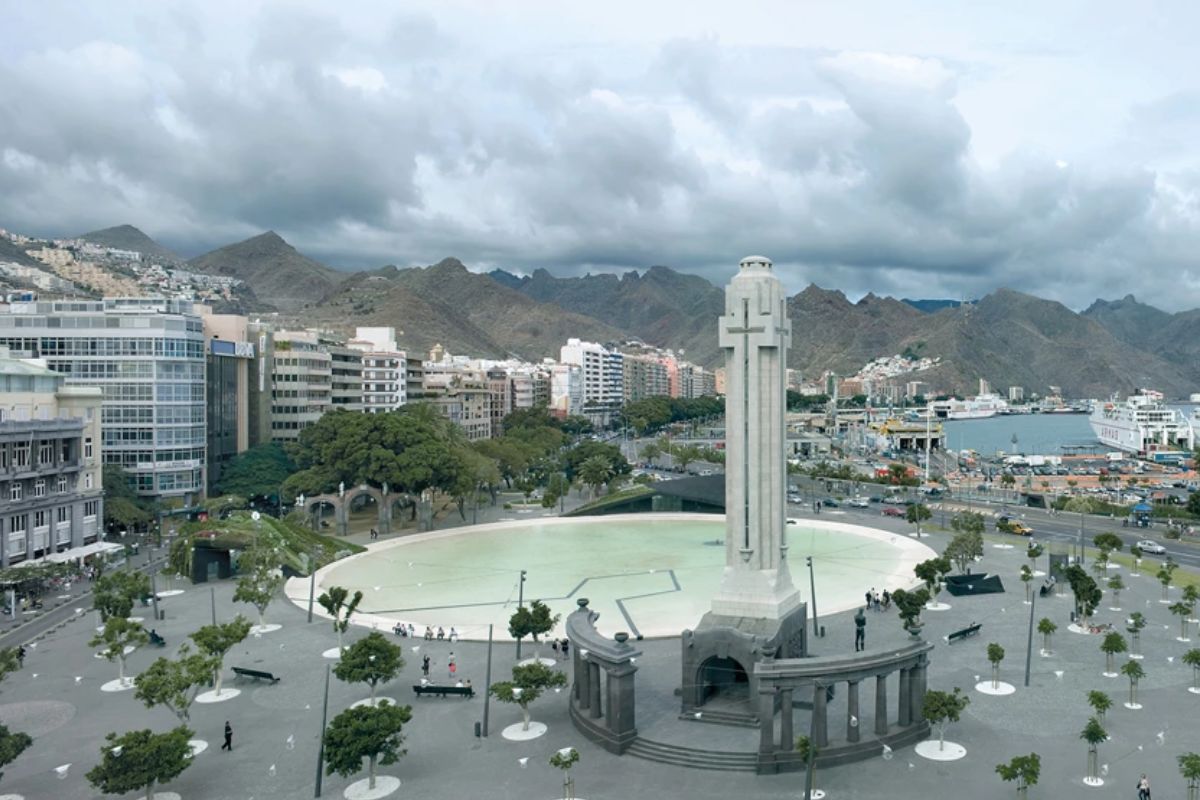
What to see and do in a day in San Cristobal de La Laguna
San Cristobal de La Laguna, declared a World Heritage Site by UNESCO, is a historical and cultural jewel that invites you to get lost in its streets full of history, colonial architecture and a vibrant atmosphere.
Morning “Stroll through the historic center”: Its pedestrian streets, squares and colorful facades are a delight for the senses. Don’t miss the Plaza del Adelantado, center of the city, surrounded by emblematic buildings such as: the Cathedral of La Laguna, a magnificent example of Canarian Gothic, and the Casa de los Capitanes, which hosts temporary exhibitions and cultural events. Also stroll along Obispo Rey Redondo Street, full of local stores and small art galleries. It is the perfect time to enjoy a Canarian coffee accompanied by a typical sweet in one of its cozy terraces. A visit to the local market Mercado de La Laguna is an enriching experience to get to know fresh products and Canarian handicrafts.
Noon “Museums and cultural corners”: Take some time to visit the Museum of History and Anthropology of Tenerife, where you will discover the historical and cultural evolution of the island, from its origins to the present day. Another interesting stop is the Convent of San Agustin, an emblematic building that offers a glimpse into the religious and architectural past of La Laguna. For lunch, you can choose from downtown restaurants that offer traditional Canarian cuisine with modern touches. Where they have dishes like rabbit in salmorejo or papas arrugadas con mojo (wrinkled potatoes with mojo) are amazing!
Afternoon “Nature and panoramic views”: Do not miss the Parque La Vega, a green space ideal for walking, relaxing and enjoying nature in the city. You can also visit the Mirador de la Mesa Mota, from where you can contemplate breathtaking views of the valley and the Teide, perfect for photography lovers. If you want to continue visiting urban art, be sure to explore the less traveled streets, where murals and graffiti reflect local creativity and bring a contemporary atmosphere to the historic city.
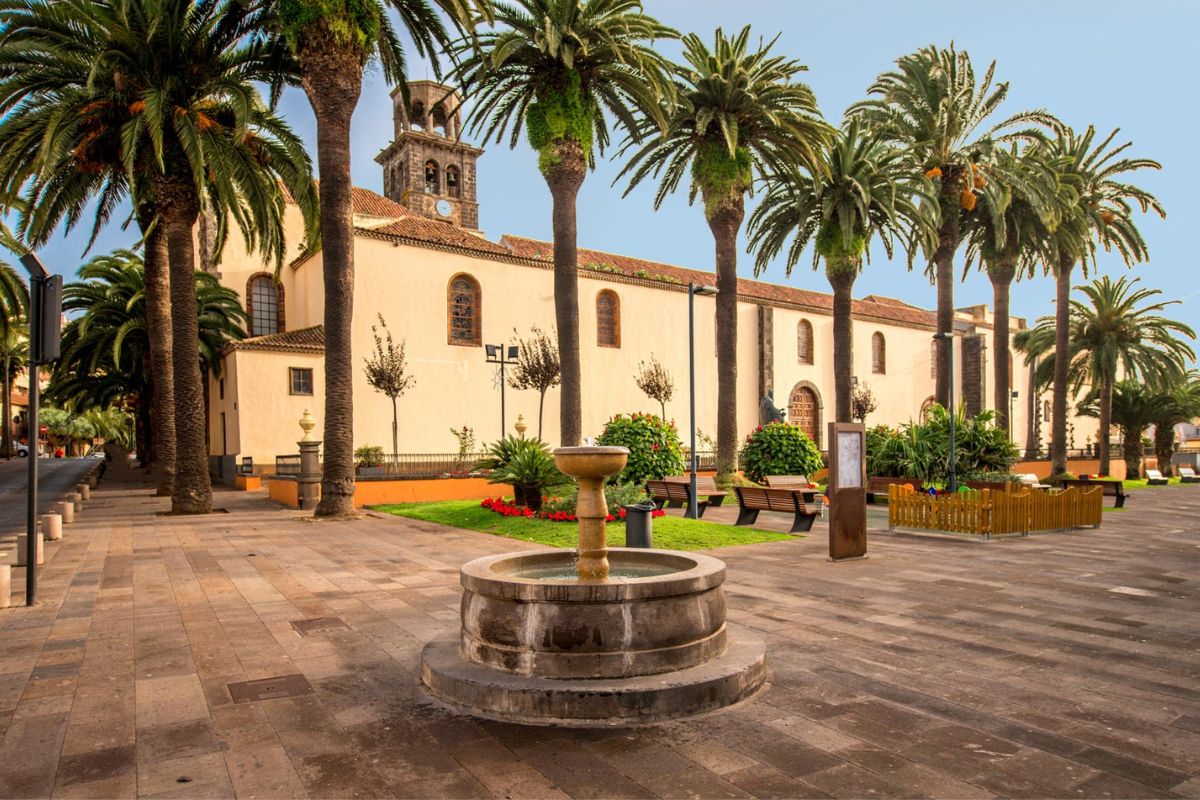
Treasures and monuments of the past
Beyond its volcanic landscapes, beaches and natural surroundings, Tenerife has a long and fascinating history that can be seen in its streets,churches, fortresses and convents. The island has witnessed different cultures, conquests, cultural exchanges and decisive moments. To walk through its monuments is to immerse oneself in centuries of history, discovering how the past is still present in its identity.
One of the historical emblems par excellence is the Church of La Concepción, with seats in both Santa Cruz and San Cristóbal de La Laguna. The La Laguna church, built in the 16th century, was the first parish church on the island and still preserves elements of Mudejar, Gothic and Baroque style. Its tower, visible from different parts of the city, has become a local icon. The church of the same name in Santa Cruz is simpler, but equally significant, as it was the first temple built after the Castilian conquest.
Precisely in Santa Cruz is another key monument “El Castillo de San Cristobal”, which today remains hidden under the Plaza de España. This castle was one of the main defenses of the city against the attacks of corsairs and foreign powers between the sixteenth and nineteenth centuries. Today it can be visited through a small subway museum where part of the original wall and the famous cannon “El Tigre” are preserved, with which, according to tradition, the British Admiral Horatio Nelson was wounded in 1797 during his failed attempt to conquer the island.
To the north, in the heart of San Cristóbal de La Laguna, declared a World Heritage Site by UNESCO, is the Cathedral of La Laguna, a neoclassical building whose interior houses important works of sacred art and the remains of the conqueror Alonso Fernández de Lugo. Its dome, imposing and greenish, crowns the sky of this historic and university city.
Another place that captivates with its character is the Antiguo Convento de San Francisco in Garachico. This town, which was one of the most prosperous ports of Tenerife before being partially destroyed by the eruption of the Trevejo volcano in 1706, retains an almost intact colonial architecture. The convent, although affected by lava, retains its original cloister and houses a museum of sacred art. Garachico, with its cobblestone streets, quiet squares and stately homes, is an open-air museum.
In Puerto de la Cruz, another of the most emblematic enclaves of the north, is the Castillo de San Felipe, built in the 17th century to protect the coast from pirate raids. Restored and converted into an exhibition hall, this small defensive bastion is part of the promenade of a city that naturally blends the historical with the contemporary.
Undoubtedly, one of the most visited and venerated temples of Tenerife is the Basilica of Our Lady of Candelaria, in the municipality of the same name. The Virgin of Candelaria, patron saint of the Canary archipelago, is venerated there. Its location in front of the Atlantic Ocean makes it an imposing sight, and in its square stand the statues of the nine Guanche menceys, ancient indigenous kings of the island, as a symbol of Tenerife’s aboriginal past. Every August 15, thousands of pilgrims gather there to celebrate their festivity.
If you are interested in traditional domestic life, you cannot miss La Casa de los Balcones, in La Orotava. This 17th century building is a splendid example of typical Canarian architecture, with its carved wooden balcony and interior courtyard full of vegetation. Today it serves as an ethnographic museum and craft store, where you can learn about traditional crafts such as embroidery, basket weaving and the making of traditional costumes.
Another lesser known jewel but with a strong symbolic value is the Ermita de San Blas, located next to the famous Cueva de Achbinico in Candelaria, where, according to legend, the image of the Virgin appeared to the Guanches before the arrival of
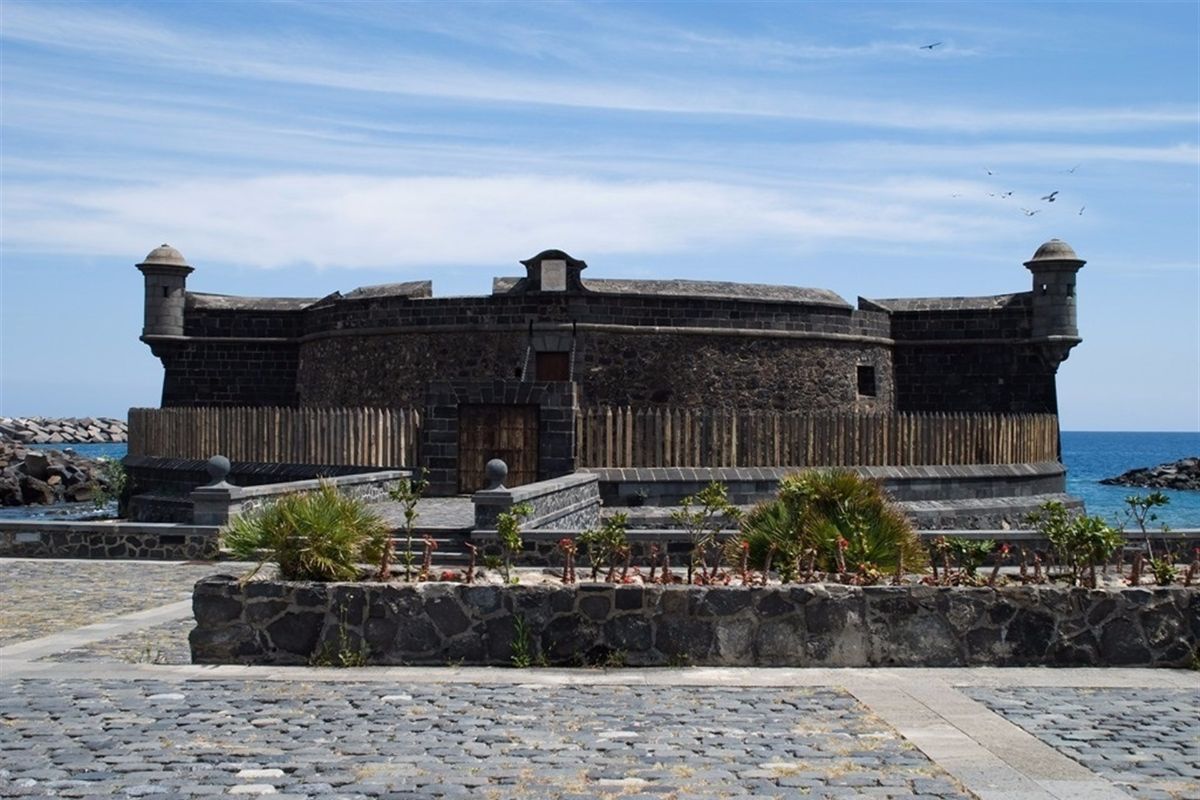
Discover the most beautiful villages with corners you will never forget.
Although Tenerife is known worldwide for its beaches and volcanic nature, it is in its villages that the island reveals its most authentic essence. Cobblestone streets, wooden balconies and lively traditions invite you to get lost in towns that have preserved their unique identity.
La Orotava
Located in the north of the island, this town is an authentic open-air museum. Its historic center, declared a Historic-Artistic Site, is full of stately mansions, interior courtyards and facades with typical Canarian balconies carved in wood. One of its icons is the Casa de los Balcones, but the gardens of the Marquesado de la Quinta Roja and the baroque Iglesia de la Concepción also stand out. It is also famous for its carpets of flowers and volcanic sands during Corpus Christi.
Garachico
This picturesque coastal town was once the most important commercial port of the island, until the eruption of the Trevejo volcano in 1706. Today, Garachico is a place of unique beauty, with a well-preserved historic center and monuments such as the Castle of San Miguel or the old Convent of San Francisco. Its natural pools of El Caletón, formed by lava, are a unique tourist attraction.
Taganana
In the middle of the Anaga Rural Park, this small coastal village offers a perfect combination of mountain and sea. Its white houses are located on the hillside and from its narrow streets, you can contemplate spectacular views of the ocean. Taganana is an ideal place for lovers of hiking and wild nature, with routes that connect with beaches such as Almáciga and Benijo. In addition, a strong gastronomic tradition is preserved here, as many locals recommend trying the fresh fish with wrinkled potatoes and mojo in their family restaurants.
Vilaflor
At more than 1,400 meters above sea level, Vilaflor is the highest village in Tenerife. From here depart several routes to the Teide National Park. Its historical heritage includes the church of San Pedro Apostle and several traditional houses. It is also the birthplace of the first Canarian saint, San Hermano Pedro, whose figure is highly revered by the islanders.
Tegueste
Located near La Laguna, Tegueste is a town with a strong rural identity and strong cultural roots. It is famous for its popular festivities, especially the pilgrimage of San Marcos, one of the most traditional of the island. Its old town is cozy, with quiet streets, shady squares… Here you can breathe authentic village life, with orchards, wineries and markets of local products.
Chew
Hidden among the ravines of the Teno massif, Masca is one of the most picturesque and visited villages of Tenerife. It is a perfect destination for photography and hiking lovers. The famous Ruta del Barranco de Masca descends to a wild beach and is one of the most spectacular hikes on the island. The village itself preserves its traditional architecture, and the views from its terraces are unique.
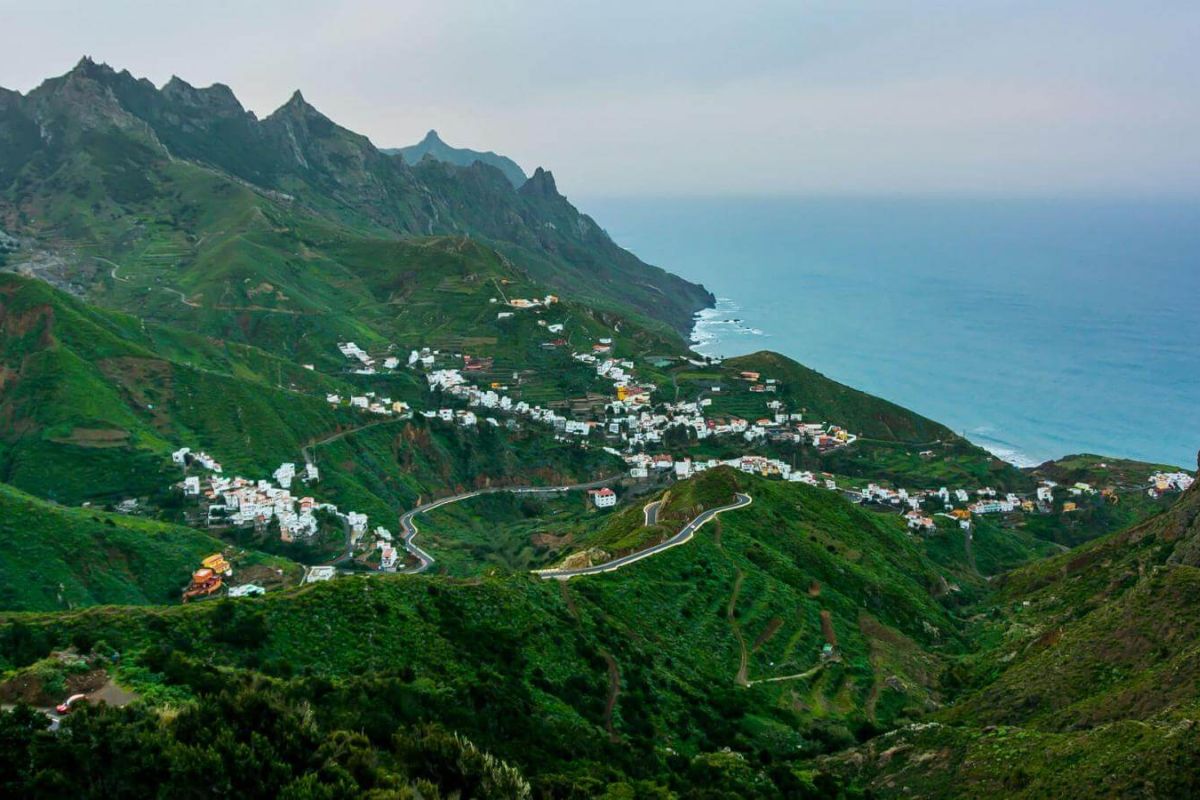
Discover the authentic products and flavors of Tenerife
The 3 most typical products of Tenerife
Tenerife Honey
Honey is a unique product, valued for its flavor and characteristics derived from the volcanic flora of the island. Particularly noteworthy are the honeys of tajinaste and retama, endemic plants that grow in the high volcanic areas, such as in the Teide National Park or in the region of Vilaflor. Beekeeping in Tenerife combines traditional and sustainable techniques, respecting the natural cycles of the bees and the seasons. Tenerife honey is used both in local gastronomy and in beauty and health products.
Artisanal goat cheese
Canary Island cheese, especially goat cheese, is another product with a strong local identity. In Tenerife, it is produced in rural areas such as the north and center of the island, where livestock farming has been traditionally maintained. The cheeses can be fresh, cured or smoked, and many are made using artisanal methods that respect tradition. The goats’ feed includes natural pastures and native plants, which gives the cheese a distinctive and deep flavor.
Tenerife Wine
Tenerife has five Denominations of Origin for its wines: Tacoronte-Acentejo, Valle de La Orotava, Ycoden-Daute-Isora, Valle de Güímar and Abona.
The vineyards are located at various altitudes and volcanic terrains, which adds complexity and variety to the wines. Farmers combine traditional techniques with modern methods to cultivate native varieties such as Listán Negro and Listán Blanco. Tenerife wines stand out for their freshness, fruity and mineral aromas, which have earned them international recognition.
Main courses
Sancocho Canario
Traditional dish based on salted fish that is cooked and served with sweet potatoes, wrinkled potatoes and mojo. The fish is prepared beforehand and cooked slowly to maintain its flavor and texture.
Old Clothes
A stew made with leftover cooked meat (chicken, pork or beef), chickpeas, tomato, bell pepper, onion and spices. It is usually served with rice or wrinkled potatoes.
Side dishes
Wrinkled Potatoes with Mojo
Small potatoes are cooked in very salted water until the skin is wrinkled and slightly dry. They are accompanied with red mojo or green mojo. Although it is a side dish, their intense flavor makes them a fundamental part of any Canarian meal.
Typical desserts
Canarian Bienmesabe
A traditional sweet made with ground almonds, eggs, sugar, lemon and cinnamon. It is simmered until a creamy texture similar to a thick custard is achieved. It is served cold and often accompanied by ice cream or fruit.
Sweet Potato Trout
They are sweet pastries filled with a mixture of cooked sweet potato, sugar, ground almonds and cinnamon. They are fried or baked until golden brown. They are especially consumed at Christmas, but are a classic all year round.
Touring Tenerife is much more than exploring a tourist destination, it is to immerse yourself in an island that surprises in every corner. From its perfect waves for surfing to its routes between volcanoes. It is a place to live without haste, to discover little by little, and to always remember.
Tenerife is an island to surf it, to live it, and above all, to repeat it. If you have come this far, it is because you have loved it.
Related articles

Types of Surfboards and what they are used for (Materials and Measurements)
There are many types of surfboards, different sizes and materials for every need or skill level. Every self-respecting surfer should understand when to use each one and know how to differentiate one from another, this is something that we will teach you in our surf school in Lanzarote, but if

How to measure the height of a wave
BOOK NOW How to measure the height of a wave You probably want to know how to measure the height of a wave. Let’s see some of the possibilities we have to do it. How do you measure the height of a wave? Knowing how to measure a sea wave

How are waves formed? Everything a surfer needs to know
BOOK NOW How are waves formed? Everything a surfer needs to know You may have wondered on more than one occasion how waves are produced. Let’s take a look at everything you need to know. What are waves? The first thing to understand, of course, is what waves are. There
